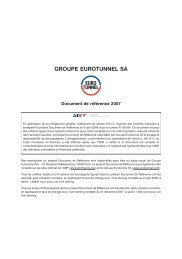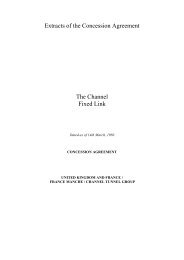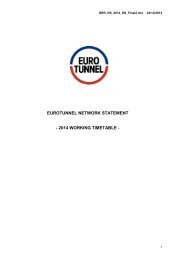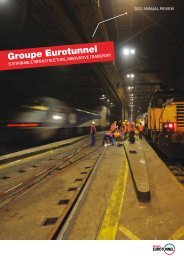2007 Reference Document for Groupe Eurotunnel SA PDF file size
2007 Reference Document for Groupe Eurotunnel SA PDF file size
2007 Reference Document for Groupe Eurotunnel SA PDF file size
Create successful ePaper yourself
Turn your PDF publications into a flip-book with our unique Google optimized e-Paper software.
6. DESCRIPTION OF EUROTUNNEL GROUP’S ACTIVITIES increase revenue from the Freight Shuttle Service from 2006 to <strong>2007</strong>.For further details, see chapter 9 of this <strong>Reference</strong> <strong>Document</strong>.This approach has been further consolidated in <strong>2007</strong>. Additional departures are available during certain periods,and the daily timetables have been improved. As part of a project entitled ‘‘Harmony’’, <strong>Eurotunnel</strong> Group haschanged the way it schedules maintenance work cycles on the Tunnel in order to optimise the Tunnel’s capacityduring peak periods. For example, by shifting work previously done on Friday and Sunday nights to other timesduring the week, <strong>Eurotunnel</strong> Group has been able to schedule more than 800 additional Freight Shuttle departuresper year on Friday evenings and Monday mornings.The new approach has also yielded better visibility in terms of traffic <strong>for</strong>ecasting, as some major customers haveentered into multi-year contracts with <strong>Eurotunnel</strong> Group. Such contracts enable customers to lock in theirrequirements in terms of the number of crossings and enable <strong>Eurotunnel</strong> Group to fine-tune its capacity planning.Marketing networkOn 16 August 2005 TNU took back control of its distribution activities and pricing policy in Europe by terminating itscontract with the intermediary that had previously handled the marketing of Shuttle crossings to small and medium<strong>size</strong>d haulers. Five distribution subsidiaries were set up in Europe in 2005. <strong>Eurotunnel</strong> SE intended to merge thesefive subsidiaries and, during the first half of 2008, <strong>Eurotunnel</strong> Group transferred the business of four of thesesubsidiaries, <strong>Eurotunnel</strong>Plus Distribution, <strong>Eurotunnel</strong>Plus SL, <strong>Eurotunnel</strong>Plus <strong>SA</strong>S and <strong>Eurotunnel</strong>Plus GmbH to<strong>Eurotunnel</strong> SE with an effective accounting and tax date of 1 January 2008. It is specified that the transfer of<strong>Eurotunnel</strong> B.V. is expected to occur in 2008.These transfers were achieved by:A universal transfer of the assets and liabilities of <strong>Eurotunnel</strong>Plus <strong>SA</strong>S and <strong>Eurotunnel</strong>Plus SL to <strong>Eurotunnel</strong>PlusDistribution and a universal transfer of the assets and liabilities of <strong>Eurotunnel</strong>Plus Distribution to <strong>Eurotunnel</strong> SE,which led to the dissolution and subsequent liquidation of these subsidiaries; The transfer of the assets of <strong>Eurotunnel</strong>Plus GmbH to <strong>Eurotunnel</strong> SE on 11 January 2008.These subsidiaries are supplemented by a network of exclusive agents and distributors.b) Passenger Shuttle ServiceIntroductionThe Passenger Shuttle Service provides <strong>for</strong> the transport of cars, motor homes, caravans, coaches, motorcyclesand trailers between France and the United Kingdom. Travellers can purchase tickets in advance at <strong>Eurotunnel</strong>Group’s website, www.eurotunnel.com, by telephone from the customer service centre, from travel agencies, orwhen they arrive at check-in. They remain in their vehicle throughout the trip through the Tunnel, which normallylasts approximately 35 minutes from plat<strong>for</strong>m to plat<strong>for</strong>m. Each Passenger Shuttle train has two sections: adouble-deck section mainly <strong>for</strong> cars and motorcycles and a single-deck section reserved <strong>for</strong> vehicles higher than1.85 metres, mainly coaches, minibuses and cars towing caravans.<strong>Eurotunnel</strong> Group has nine Passenger Shuttles, each able to carry up to 180 cars or 120 cars and twelve coaches. Inlight of the new commercial strategy, only eight Passenger Shuttles were in service in <strong>2007</strong>.The Passenger Shuttle Service currently operates up to three departures per hour in each direction.In comparison to 2006, the total number of vehicles transported in <strong>2007</strong> increased by 6% <strong>for</strong> cars and decreased by3% <strong>for</strong> coaches. For more details, see chapter 9 of this <strong>Reference</strong> <strong>Document</strong>.23







